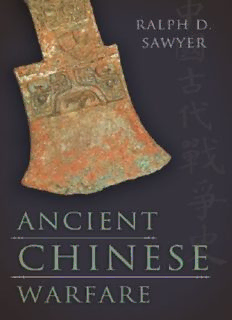Table Of ContentTable of Contents
Title Page
Dedication
PREFACE
A NOTE ON PRONUNCIATION
Chapter 1. - PRELIMINARY ORIENTATIONS AND LEGENDARY
CONFLICTS
THE SEMILEGENDARY PERIOD
Chapter 2. - ANCIENT FORTIFICATIONS, I
CHARACTER AND FUNCTION OF EARLY WALLS
EVOLUTION OF THE FORTIFIED TOWN
Chapter 3. - ANCIENT FORTIFICATIONS, II
SICHUAN PRECURSORS
FORTIFICATION TECHNOLOGY AND METHODS
Chapter 4. - THE HSIA
ORIGINS AND PREHISTORY
EARLY SITES AND CAPITALS
RESOURCE CONTROL POINTS
Chapter 5. - WARFARE IN THE HSIA
POLITICAL ORGANIZATION AND MILITARY STRUCTURE
Chapter 6. - THE SHANG DYNASTY
TRADITIONAL ACCOUNT OF THE SHANG’S RISE
CONQUEST OF THE HSIA
Chapter 7. - SHANG CAPITALS, CITADELS, AND FORTIFICATIONS
STRATEGIC ASSESSMENT AND HISTORICAL IMPLICATIONS
SHANG EXTENT AND FLUCTUATIONS
Chapter 8. - CHAOS, CONTRACTION, AND RESURGENCE
LATE SHANG: THE ANYANG PERIOD
MARTIAL ACTIVITIES IN THE ANYANG ERA
Chapter 9. - KING WU TING, I
WU TING’S EARLY PERIOD
WU TING’S MIDDLE PERIOD
Chapter 10. - KING WU TING, II
WU TING’S LATE PERIOD
WU TING’S COMMANDERS
Chapter 11. - THE LAST REIGNS
CONFLICTS AND CAMPAIGNS
Chapter 12. - THE SHANG MARTIAL EDIFICE
SHANG MARTIAL COMMAND
SHANG MILITARY CONTINGENTS
Chapter 13. - TROOPS, INTELLIGENCE, AND TACTICS
SHANG MILITARY INTELLIGENCE
OPERATIONAL TACTICS
TRAINING
Chapter 14. - METALLURGICAL EVOLUTION IN CHINA
THE SHANG REALIZATION
Chapter 15. - EARLY WEAPONS AND THE AXE
THE AXE
Chapter 16. - KNIVES, DAGGERS, AND SWORDS
DAGGERS AND SWORDS
Chapter 17. - THE KO OR DAGGER-AXE
THE CHI
Chapter 18. - SPEARS AND ARMOR
ARMOR AND SHIELDS
Chapter 19. - ANCIENT ARCHERY
DESIGN, POWER, AND ACCURACY OF THE BOW
EARLY CHINESE BOWS
THE ARROW
Chapter 20. - THE CHARIOT IN CHINA
DESIGN AND SPECIFICATIONS
ORIGINS
Chapter 21. - THE HORSE IN CHINA
TRAINING
ROLE AND EFFECTS
HORSEPOWER
Chapter 22. - THE CHARIOT IN BATTLE
WARRIOR COMPLEMENT AND ACTIONS
INTEGRATION WITH ACCOMPANYING FORCES
Chapter 23. - CHARIOT LIMITATIONS AND DIFFICULTIES
COMBAT ISSUES
Chapter 24. - ANCIENT LOGISTICS
Chapter 25. - MUSINGS AND IMPONDERABLES
CONQUEST AND DISPLACEMENT
✦ NOTES ✦
✦ INTEGRATED BIBLIOGRAPHY ✦
✦ INDEX ✦
Copyright Page
FOR
LEE MEI-CHÜN
PREFACE
ANCIENT CHINESE WARFARE AND ITS COMPANION, Western Chou
Warfare, were started more than thirty years ago but were soon de-emphasized,
though never abandoned, to investigate more accessible topics because
insufficient archaeological material was available for assessing many aspects of
ancient Chinese military history. Even though dramatic new finds such as San-
hsing-tui (Sanxingdui) can still provoke astonishment and significantly affect
historical understanding, the accumulation of thousands of discoveries and
hundreds of highly relevant reports over the intervening decades has not only
resulted in something akin to a minimal critical mass, but also considerably
diminished the impact of archaeology’s accidental nature. To cite just one
example, reports on Wangch’eng-kang in the early 1980s indicated the existence
of a fortress consisting of two small but conjoined square citadels roughly 100
meters on a side that immediately prompted heated arguments about its possible
identity as an ancient Hsia (Xia) capital. However, a partial excavation of the
greater site in the early twenty-first century has now revealed that the “King’s
City” once enclosed a massive 300,000 square meters within its substantial outer
fortifications, considerably buttressing claims for an imperial role.
Although my efforts over the last few years, whether in the cold of Korean
winters or heat of interminable Indonesian summers, have been focused on this
volume, many more could easily be spent. No one has ever been granted
indefinite longevity, yet it is difficult to escape the persistent feeling that only
now, after nearly a half century of pondering Chinese topics, am I approaching
some requisite level of understanding upon which the entire topic should be
restudied. This is particularly true with respect to the ancient period because of
the inescapable necessity of relying on innumerable interpretive archaeological
reports and scholarly explications of oracular and bronze inscriptional materials,
the core of this book.
Despite the convenience of the Internet and the growth of extensive (but not
yet fully accessible or comprehensive) databases, exhaustive examination of all
relevant articles on any single aspect of ancient Chinese military history, even
something as focused as arrowheads, remains impossible. Paradoxically,
numerous materials that were once relatively available through interlibrary loan,
especially Japanese books and articles, have become even more difficult to
Description:The history of China is a history of warfare. Rarely in its 3,000-year existence has the country not been beset by war, rebellion, or raids. Warfare was a primary source of innovation, social evolution, and material progress in the Legendary Era, Hsia dynasty, and Shang dynasty--indeed, war was the

